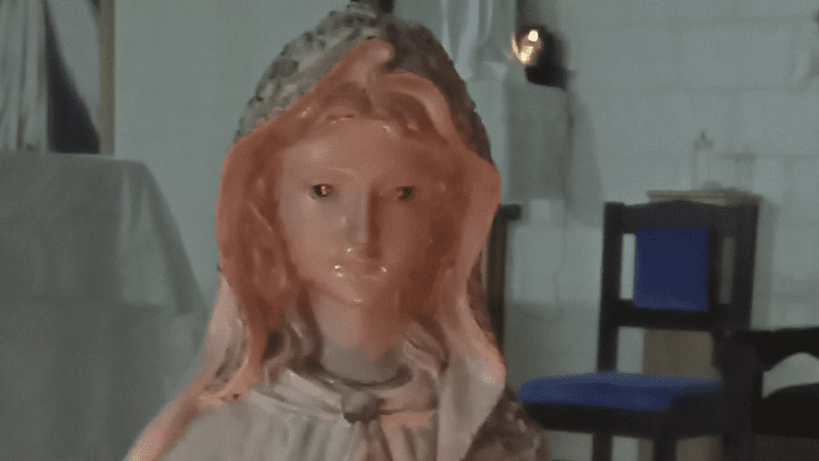
Crying Virgin Mary Pacific Island, Tongatapu |

May 21, 2024 - Reported [here]. Crying Virgin Mary statue with tears reported in Tonga as Vatican updates rules on apparitions.
Churchgoers in Tonga claim to have witnessed a miracle after spotting a statue of the Virgin Mary that appeared to have real tears rolling down her cheeks. Sr Siu Moata’ane at Tongatapu’s St Michael Catholic Church of Lapaha reported the incident on April 5. “The Statue of Mary the mother of God is crying”, she claimed on Facebook. She also posted images of the statue of the Virgin Mary with water droplets seemingly emerging from the statue’s eyes and running down her face. Sr Moata’ane, along with others, also reported that the weeping Madonna drew throngs of skeptics and believers alike in Tonga from other churches and the island of Niue, with many pilgrims claiming that it was a sign from God. The nun posted several prayers to accompany images of the weeping Mary on Facebook with one saying she believed the misty-eyed Mary was weeping to save the people of Tonga from the immorality which had befallen the country. Last week King Tupou VI expressed his grave concern at the level of the illicit drugs crisis that has infiltrated every part of society, from villages, schools, and the government. The king was also worried about families being broken apart by affairs caused while one of the parents left the kingdom to take part in foreign seasonal worker schemes. It is understood the weeping statue is currently being transported around in Tonga among various parishes.
2017 apparition
In 2017 Tongan Catholics claimed they had evidence of what they believed was a miraculous apparition of the Virgin Mary in the sky. A photograph has surfaced appearing to show a divine figure in the sky above the Pacific island nation of Tonga. The image was taken by Joey Mataele on January 1 in the sky above his brother’s house in the village of Halaleva in Tongatapu. The cloud appeared to resemble the kind of statue of the Virgin commonly seen in church. It had a clear outline of a head, body and feet and a golden glow from the sun. Mataele said he believed it was a sign from heaven. Unlike the other clouds around it, the statue-shaped cloud retained its form for some time. It was claimed that it also glowed more brightly than the other clouds.
Vatican updates rules on weeping statues
The Catholic Church has a long and controversial history of the faithful claiming to have had visions of the Virgin Mary, of statues that purportedly wept blood tears and stigmata that erupted on hands mimicking the wounds of Christ. On Friday, the Vatican announced new guidelines to help determine whether and when these seemingly supernatural events were authentic. According to the BBC, the document, compiled by the Vatican’s Dicastery for the Doctrine of the Faith, lays out stricter rules to assess the truthfulness of such claims. The new guidance was presented at a media briefing on Friday and replaces rulings last set out in 1978. The document recommends incidents of phenomena should be carefully assessed, to make sure that they are not fraudulent or an attempt to make money. The paper warns against creating “damage to the unity of the Church” and serious errors that could “cause scandals and undermine the credibility of the Church”. Reports of such phenomena are said to have soared in recent years in an era of social media – sometimes spread through disinformation and rumour. The new guidelines say that as a rule, bishops should issue a “nihil obstat” – or no obstacle – in such cases. This means that the incident would not be formally recognised as supernatural, but that there would be no barrier to worship. Supernatural recognition by the Vatican is rare. The document goes on to say that five other decisions can also be issued by bishops, including rejecting the event as supernatural altogether or even banning the worship of some phenomena. Under the new rules, Vatican approval should always be sought by bishops before any conclusions are published, with the Pope able to intervene in exceptional cases. Apparitions have been reported across the centuries. Those recognised by the Church have prompted pilgrims, and popes, to visit spots where they are said to have taken place. Millions flock to Lourdes in France, for example, or Fatima in Portugal, where the Virgin Mary is alleged to have appeared to children, promising a miracle – after which crowds are said to have witnessed the sun zig-zagging through the sky. The visitation was officially recognised by the Church in 1930. .But other reports have been found by church officials to be untrue. In 2016, an Italian woman began claiming regular apparitions of Jesus and Mary in a small town north of Rome after she brought back a statue from Medjugorje in Bosnia, where the Virgin Mary is also said to have appeared. Crowds prayed before the statue and received messages including warnings against same-sex marriage and abortion. It took eight years for the local bishop to debunk the story. The shrine was not mentioned in the new guidance. Claims of supposedly miraculous happenings and messages from Mary at Medjugorje itself have been the subject of controversy. Pope Francis himself said in 1917: “I prefer the Madonna as a mother, our mother, and not a woman who’s the head of a telegraph office who sends a message every day at a certain time,” The new rulings say many pilgrimage sites linked to supposed phenomena have not received authentication from the Vatican, but that this did not pose problems for the Church. And so the Vatican, an institution peppered with mysticism, and which still communicates via smoke signals when electing a new pope, will be hoping its new rules can regulate claims of the supernatural. |